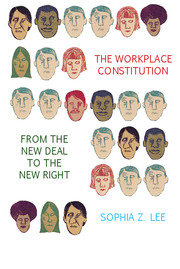Book contents
- Frontmatter
- Contents
- Acknowledgments
- Introduction
- Part I Crafting the Workplace Constitution in the New Deal 1930s and 1940s
- Part II Advancing the Workplace Constitution in the Cold War 1950s
- 4 Liberals Test the Workplace Constitution in the Courts
- 5 Agencies Consider the Liberal Workplace Constitution
- 6 Conservatives Pursue the Workplace Constitution in the Courts
- Part III Administering the Liberal Workplace Constitution in the Long 1960s
- Part IV The Workplace Constitution in the New Right 1970s and 1980s
- Epilogue
- Appendix: Figures
- Notes
- Selected Bibliography of Primary Sources
- Index
6 - Conservatives Pursue the Workplace Constitution in the Courts
Published online by Cambridge University Press: 05 October 2014
- Frontmatter
- Contents
- Acknowledgments
- Introduction
- Part I Crafting the Workplace Constitution in the New Deal 1930s and 1940s
- Part II Advancing the Workplace Constitution in the Cold War 1950s
- 4 Liberals Test the Workplace Constitution in the Courts
- 5 Agencies Consider the Liberal Workplace Constitution
- 6 Conservatives Pursue the Workplace Constitution in the Courts
- Part III Administering the Liberal Workplace Constitution in the Long 1960s
- Part IV The Workplace Constitution in the New Right 1970s and 1980s
- Epilogue
- Appendix: Figures
- Notes
- Selected Bibliography of Primary Sources
- Index
Summary
“Their individual rights and liberties as free men”
Complaint, Ward v. Seaboard Air Line Railroad Co.In 1950, Congress debated amending the Railway Labor Act to allow union shops, ones in which eligible workers were required to join the union to keep their jobs. “I and my co-workers ... believe in the necessity of unions,” Kentuckian William T. Harrison wrote several southern Congressmen, but “forced membership in either a union, club, lodge, church or anything else ... is Un-American and should be left to Russia.” As an official of the Brotherhood of Railway Clerks, Harrison’s prounion stance was sincere. His opposition to “forced membership” was equally heartfelt. It stemmed not only from patriotic anticommunism but also racial politics. The national labor leaders who pushed for union shops, Harrison objected, “seek such power to further their political ideas, which for the great part are of the F.E.P.C. and other civil rights programs of the North and East variety.” To Harrison’s chagrin, in 1951 the union shop amendments passed and his union suspended him for publicly opposing them.
The Railway Labor Act amendments transformed the right-to-work movement. Most notably, they channeled the movement’s strategy back into the courts. As discussed in Chapter 3, Hollywood mogul Cecil B. DeMille had decided that influencing public opinion was the best way to achieve a Supreme Court victory for the his cause. Instead of funding litigation, he lobbied states to adopt right-to-work laws. Individual workers still occasionally brought right-to-work suits but they were not part of any larger Supreme Court strategy. The Railway Labor Act’s amendments overrode (in legal terms, “preempted”) state right-to-work laws, however, foreclosing the state-law antidote and sending the movement back to court. Generating litigation, it turned out, was only one of several ways the amendments transformed the right-to-work movement.
- Type
- Chapter
- Information
- The Workplace Constitution from the New Deal to the New Right , pp. 115 - 132Publisher: Cambridge University PressPrint publication year: 2014



